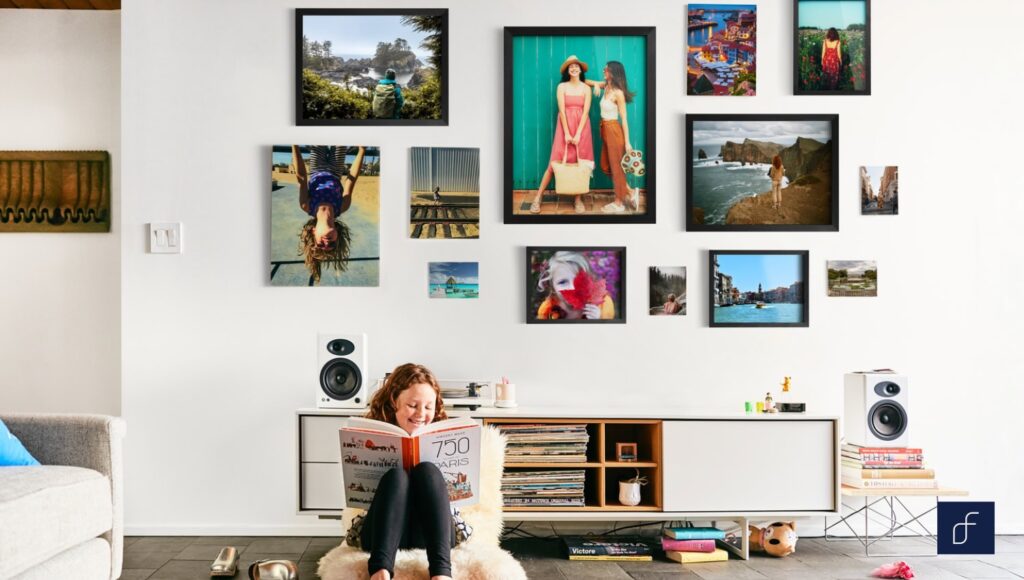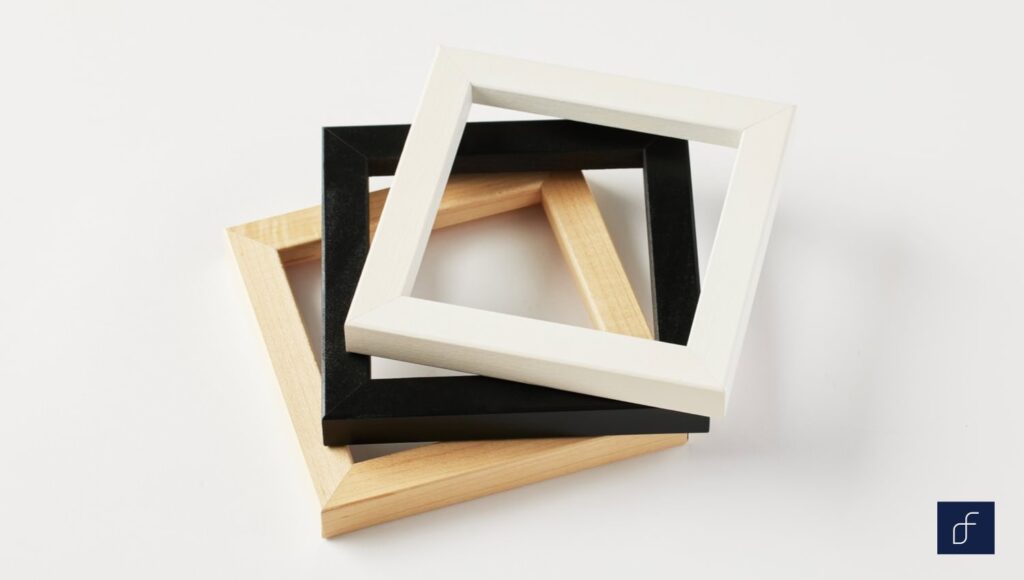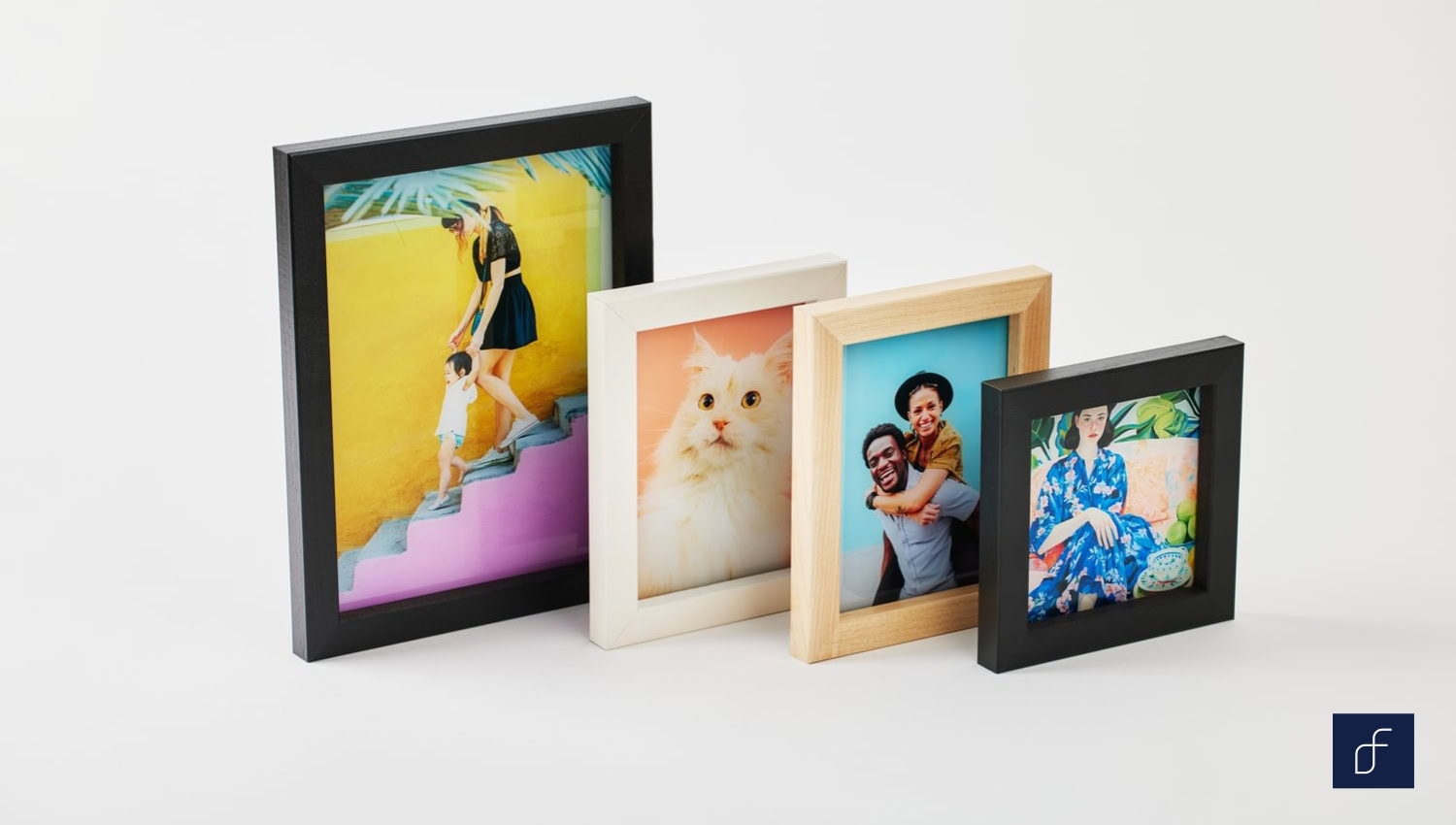Preserving and showcasing your cherished memories requires the perfect frame size. Standard frame sizes offer versatility, ensuring a beautiful fit for your treasured photographs and artwork.
Whether it’s a family portrait, a breathtaking landscape or a special moment caught on camera, the frame you select plays an underappreciated yet important role in how those images are perceived and cherished.
Unsure about which frame size to choose? Our guide will help you select the perfect option, ensuring that your memories are displayed beautifully and thoughtfully.
What is the Standard Size of a Photo Frame?
Standard frame sizes typically align with common photo dimensions, frequently offering a seamless fit for your prints. Understanding aspect ratios – the proportional relationship between an image’s width and height – is crucial when selecting the right frame, especially for digital photos.

The standard sizes of photo frames are listed below:
- 4×6: Ideal for small photos, perfect for table displays or creating a collage wall.
- 5×5: A square option that’s great for Instagram-style or artistic images, adding a modern touch to your decor.
- 5×7: Suitable for portraits and small landscapes, offering just the right balance of size and intimacy.
- 8×10: A popular choice for portraits and wall displays, this size is versatile enough to be the centerpiece of any table, shelf or countertop in a room.
- 11×14: Perfect for framed prints or artwork, providing a bold statement without overwhelming the space.
- 16×20: Great for large portraits or art pieces, and ideal for adding a focal point to your wall.
- 20×24: Works well for statement pieces, giving your room a touch of elegance and importance.
- 24×30: Ideal for enlargements and impactful prints that deserve to stand out.
- 24×36: Excellent for poster-sized images, bringing cinematic impact to your decor.
Frame Size Comparison Table
Here’s a quick comparison to help you choose the right frame size for your specific needs:
| Frame Size (Inches) | Frame Size (Centimeters) | Recommended Image Size (Pixels) | Ideal Uses | Visual Proportions | Recommended Locations |
|---|---|---|---|---|---|
| 4×6 | 10×15 | 1200×1800 | Casual snapshots, collages | Compact and versatile | Home or office desk, shelves |
| 5×5 | 13×13 | 1500×1500 | Instagram photos, art prints | Modern, balanced | Living room, office shelves |
| 5×7 | 13×18 | 1500×2100 | Portraits, landscapes | Intimate and focused | Hallways, bedrooms |
| 8×10 | 20×25 | 2400×3000 | Portraits, wall displays | Versatile and classic | Any room |
| 11×14 | 28×36 | 3300×4200 | Framed art, photography | Bold, yet manageable | Living rooms, office walls |
| 16×20 | 40×51 | 4800×6000 | Large portraits, art | Striking and impactful | Statement walls, hallway entry/exit points |
| 20×24 | 51×61 | 6000×7200 | Statement pieces | Elegant and prominent | Galleries, foyers, building entrances |
| 24×30 | 61×76 | 7200×9000 | Enlargements, impact prints | Dramatic and powerful | Large walls, theaters, conference rooms |
| 24×36 | 61×91 | 7200×10800 | Posters, art prints | Cinematic and immersive | Office reception areas, home theaters |
Choosing the Right Frame Size for Your Images
Photos taken with modern smartphones usually look fantastic in standard-sized frames. However, it’s important to be mindful when sending pictures through messaging apps, as these apps often compress files and reduce their resolution. To achieve the best print quality, always use the original image file, ideally transferred via email at full resolution.
Digital vs. Physical displays
For digital images, consider the resolution and aspect ratio before printing. High-resolution photos with a 4:3 or 16:9 aspect ratio are often best suited for larger frames. In contrast, traditional film photos or standard digital camera shots usually have a 3:2 aspect ratio, making them ideal for more conventional frame sizes.
Matching frame sizes to room aesthetics
The frame size should complement both the image and the space where it will be displayed. For example, a large 24×36 frame might be overwhelming in a small room but could make a suitable focal point piece in a spacious living area. Conversely, smaller frames like 4×6 or 5×7 are ideal for intimate spaces or for creating a gallery wall.
Non-Standard and Custom Frame Options
While standard sizes are convenient, non-standard and custom frame sizes offer unique possibilities for showcasing special pieces. At Fracture, we offer custom sizing options that allow you to create the perfect frame for your image, no matter its dimensions.
Square and large format frames
Square frames are particularly popular for modern and minimalist designs, often used for Instagram photos or abstract art. Large formats, such as 20×24 or 24×36, are perfect for creating impactful prints that command attention in any room.
Practical Tips for Measuring and Choosing Frames
Selecting the right frame size begins with accurate measurements. Whether you’re framing a cherished photo memory or a piece of sentimental artwork, these steps will ensure your frame fits perfectly:
- Measure Your Image: Start by measuring the width and height of your image. Use a ruler or measuring tape to measure from edge to edge. For best results, measure in both inches and centimeters.
- Consider Matting: If you plan to add a mat around your image, remember that this will require a larger frame. Measure the width of the mat and add it to the dimensions of your image to determine the correct frame size.
- Measure Your Wall Space: Before choosing a frame, measure the wall space where you plan to hang it. This will help you select a frame size that complements the room without overpowering it. Remember to leave some space around the frame for a balanced look.
- Match Aspect Ratios: Ensure the frame size matches the aspect ratio of your image to avoid awkward cropping. For example, a 4×6 photo has a 3:2 aspect ratio, so it will fit perfectly in a 6×9 or 8×12 frame.
- Test with Tape: Use painter’s tape to outline the frame size on your wall. This will give you a visual idea of how the frame will look in the space and help you make adjustments before purchasing.
- Choose the Right Tools: Use a level to ensure your frame hangs straight, and consider a laser level for larger pieces. Always use proper wall anchors or hooks that can support the weight of your frame, especially if it’s a larger, heavier piece.
Fracture’s Commitment to Quality and Sustainability

The right frame can turn an ordinary photo into a timeless piece of art, making it a centerpiece in your home or a thoughtful gift for someone special.
At Fracture, we offer a variety of frame sizes to suit every need, from standard options to custom solutions. When you choose Fracture, you’re not just getting a frame – you’re investing in quality and sustainability. Our glass prints are crafted with precision, ensuring that every detail of your image is captured with vibrant, true-to-life colors. Explore our collection today and find the perfect frame to showcase your memories in the most stunning way possible.
Unlike traditional frames, our prints require no additional glass or matting, offering a sleek, minimalist aesthetic right out of the delivery box. But it’s not just about looks: we’re committed to creating products that are as eco-friendly as they are beautiful. Our carbon-neutral, plastic-free prints reflect our dedication to green manufacturing and sustainability. By choosing Fracture, you’re not just getting a frame; you’re supporting a company that values creating quality goods and preserving the planet. Get started now!

FAQs on Standard Frame Sizes
Is 9×12 a standard frame size?
Yes, 9×12 is considered a standard frame size, often used for medium-sized artwork and photos.
Is 12×16 a standard frame size?
Yes, 12×16 is a standard frame size. This size is commonly used for art prints, posters and photographs, providing a balance between a small and large display.
Can standard frames accommodate matting, and how does this change the size I need?
A standard frame can accommodate matting, but it will require a larger frame size to ensure the mat fits properly around the image. For example, if you want to mat an 8×10 photo, you might need an 11×14 or 12×16 frame to accommodate the mat and the image with ample spacing to achieve aesthetic balance.
What are the implications of aspect ratios on frame size choices?
Aspect ratios determine how well your image will fit into a frame without cropping. For instance, a 4:3 aspect ratio (common in digital photos) fits perfectly in frames like 8×10, while a 3:2 aspect ratio (common in DSLR photos) fits well in 6×9 or 12×18 frames.
How do I choose a frame for a large print or poster?
When selecting a frame for a large print or poster, consider the dimensions of your wall space and the overall interior aesthetic you want to achieve in the room. Larger frames work best as focal points in spacious areas. Ensure the frame size enhances the artwork without overwhelming the room.
How do I ensure my frame size matches the resolution of my photo for the best display quality?
To ensure your frame size matches the resolution of your photo, check that your image has a high enough resolution (measured in pixels) to maintain clarity when printed. A general guideline is 300 pixels per inch (PPI) for the best print quality, so a photo for an 8×10 frame should be at least 2400×3000 pixels. You can also explore Fracture’s guide on how to print and frame photos to ensure the perfect frame size that matches the resolution of your photos.






Comments